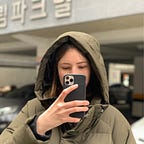Reading: Making sense of the mess.
Design an experience that reveals what happens when we read.
Group members 🤝: Gabrielle Bennet, Maria Carolina Séves, Damul Yang, Maria Shuttleworth
<<< Previous project found here: Soil: The Museum.
For this one week project we had two research methods to use:
- 📖 Literature Review
- 📲 Prototyping
Our first zoom call had us come up with a few ideas, however after some further reading, this idea morphed into exploring what happens when you can’t understand what you read.
Prototyping.
We decided to begin by making low-fidelity prototypes of some features (e.g. chrome extensions, expandable text) that could help clarify confusing concepts that readers come across:
Tutorial.
When we showed our Figma prototypes to our course leader he said we had resorted to Solutionism: we had jumped to a solution before we had really explored the problem.
His main pointers were that we needed to emphasise the experiential part of our concept — To explore how people experience confusion.
The more we thought about it, the more our topic lead towards Information Anxiety: “the uneasiness most people feel daily as they’re overwhelmed with facts and data pretending to be useful information” (Wurman, 2000).
Wurman says that you can only understand information relative to what you already understand — if you don’t understand the context, or the topic doesn’t generally interest you, then it won’t stick— “it has no velcro on it”.
Innumeracy is a problem that stacks on top on this one — so many numbers affect our lives, but many of us just cannot comprehend them (especially when overly large).
This is a huge problem in the Information Society we live in- and it makes us think: what happens if you live a life where you read more than you understand?
Prototyping, 2nd round.
We wanted to prototype the confusion that happens in our minds when reading beyond our ability. To simulate this I wrote a fake article on drunk driving full of statistics:
The mixture of incomprehensibly large numbers, percentages and unexplained acronyms (e.g. BAC and NHTSA) made for a very difficult read. I gave this fake article to a friend of mine and he annotated it with his confusion.
Following my fake article, we found similarly confusing articles and asked friends to read them. We asked them to visualise the confusing parts in any way that helps them understand.
Literature Review.
We identified five key themes from our reading: Information overload, Numbers, Visualisation, Confusion and Anxiety. We confirmed that people have a hard time understanding large numbers (over 1million). We also read that by making comparisons to objects common in people’s lives we can make it easier to visualise tricky statistics e.g. comparing figures to the size of a double-decker bus, or a football stadium. However, we did not find much of a solution to this problem, other than simply comparing the numbers to objects.
Making sense of the mess.
For this project we wanted to focus on information that has been overwhelming in the year 2020 — narrowing it down to Covid Vaccines, Marine Pollution and Obesity.
We then made lists of items that relate specifically to each article that we could get a hold of easily:
As both Maria and I could not attend class, Gabrielle and Damul were in charge of finding the physical items to bring in to class. They went to McDonalds and kept packaging for Obesity, and used masks and band-aids for Vaccines.
As an example to show the class, Gabrielle did the experiment herself with migration:
Class experience.
We split the class into groups and asked them to look through the articles, representing the information they read with the materials we provided.
We felt like the experience worked really well, and everyone agreed to having struggled to understand these kinds of overwhelming concepts in the past.
Feedback.
John commented that the activity was too structured; we left it open-ended at the beginning but we walked around the class, perhaps making people nervous. When it comes to encouraging understanding, pressure is the last thing you need, so next time we would stay out of it and let them do it alone.
This pressure to understand is perhaps the problem we were trying to overcome in the first place — we are all at risk of feeling incapable in a society that tells us knowing everything is more important than understanding it.
Moving forward, it might be good to think about the importance of decoding information for yourself, figuring our how to read in your own independent way. Given that you can only understand information relative to the knowledge you already have, it seems as if the only way to fix this problem is to encourage understanding processes over simply absorbing.
For the next project on Xenosomatics click here >>>
References.
- Bruns, A. (2015). Making Sense of Society Through Social Media. Social Media + Society, 1(1), p.205630511557867.
- Dowker, A., Sarkar, A., Looi, C.Y. (2016). Mathematics Anxiety: What Have We Learned in 60 Years? Frontiers in Psychology, [online] 7. Available at: https://www.ncbi.nlm.nih.gov/pmc/articles/PMC4842756/.
- Griffin, G. and Hayler, M. (2016). Research methods for reading digital data in the digital humanities. Edinburgh: Edinburgh University Press Ltd.
- Johnson, C., Moorhead, R., Munzner, T., Pfister, H., Rheingans, P., Yoo, T.S., (2005). NIH-NSF visualization research challenges report. IEEE..
- Landy, D., Silbert, N. and Goldin, A. (2013). Estimating Large Numbers. Cognitive Science, 37(5), pp.775–799.
- Telea, A.C., (2014). Data visualization: principles and practice. CRC Press.
- Wurman, R. S. (2000). Information anxiety. Indianapolis, Ind.: Que ; Hemel Hempstead.
- United Nations Economic Commission For Europe (2009). “Making Data Meaningful. Part 1 — A guide to writing stories about numbers”, United Nations.
